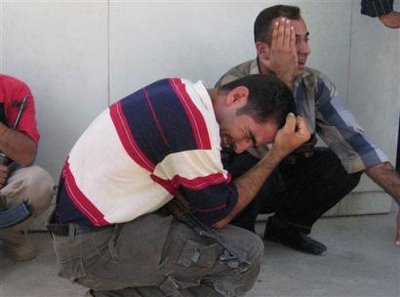How Israel put Gaza civilians in firing line
 As John Bolton vetoes a UN resolution condemning Israel's shelling of Gaza which killed nineteen innocent Palestinians, it is emerging that "Israeli military commanders drastically reduced the 'safety' margins that separate artillery targets from the built-up civilian areas of Gaza earlier this year, despite being warned that the new policy risked increasing Palestinian civilian deaths and injuries".
As John Bolton vetoes a UN resolution condemning Israel's shelling of Gaza which killed nineteen innocent Palestinians, it is emerging that "Israeli military commanders drastically reduced the 'safety' margins that separate artillery targets from the built-up civilian areas of Gaza earlier this year, despite being warned that the new policy risked increasing Palestinian civilian deaths and injuries".
Any army working within such parameters is bound to encounter civilian casualties.The warning, delivered in Israel's high court by six human rights groups, came after the Israeli Defence Force reduced the so-called 'safety range' in Gaza from a 300-metre separation from built-up areas to just 100 metres - within the kill radius of its 155mm high-explosive shells, generally regarded as being between 50 and 150 metres.
Disclosure of the new shelling policy, which went largely unnoted at the time, has emerged in international outcry over the latest artillery incident by Israeli gunners shelling Gaza - the killing of 19 members of an extended family in the Gaza town of Beit Hanoun. It was the highest Palestinian civilian toll in a single incident since the current conflict erupted in September 2000. The deaths were caused when what witnesses described as a volley of tank shells hit a built-up civilian area.
The IDF has claimed a fault in the artillery radar system's co-ordinates for the missiles changed the margin of error from 25 to 200m, but that still does not explain why it waited until the following day to return fire to a general area - a policy that the Israeli peace group B'Tselem describes as a 'war crime'.What is even more extraordinary about Israel's use of artillery shells as a means of combating the Palestinian's Qassam rocket fire, is that it is a method that Israel knows does not work.
So Israel is using a methodology that it knows to be ineffective and it has also reduced the "safety" range for this artillery fire to within the kill radius of it's own shells.As well as provoking international concern, the Beit Hanoun killings have pushed into the open deep misgivings within the Israeli military itself over its use of artillery - and the capabilities of Israeli gunners - both in Gaza, and in the recent war in Lebanon, as an effective response to missile fire.
As a point of comparison, between June 2004 and July 2006, 14 civilians (six of them minors) were killed by Qassam gunfire fired by Palestinians into Israeli territory and at settlements in the Gaza Strip. In the four weeks from 26 June-24 July this year, however, IDF actions in the Gaza Strip to end the Qassam rocket fire caused the death of 126 Palestinians, 63 of whom did not participate in the hostilities. Twenty-nine of these were minors. According to the UN, since the end of June 450 Palestinians have been killed in Gaza.
Among those who have been loudly critical of the Israeli tactics in Gaza following Beit Hanoun is Lt Col Ron Ben Yishai, defence correspondent of the newspaper Yediot Aharonot. 'Artillery is a weapon system designed to "cover" territory and not hit specific targets, particularly when it is used as "preventative fire" at territories rather than a specified target,' he wrote last week.
'These facts are well known to IDF officials, particularly after the recent Lebanon war when about 130,000 artillery shells were fired. Now it is clear that the effectiveness of this weapon against Hizbollah fighters was marginal, while the economic cost was astronomical and reached millions of dollars.
'Even before the Lebanon war it was proven that artillery fire failed in preventing or even minimising Qassam rocket fire from the Gaza Strip. This is the reason why the IDF Southern Command decided recently ... to stop, or at least highly limit, the use of preventative artillery fire.'
It's hard to look at both those facts and say that Israel is serious about avoiding civilian casualties. And it's even harder to watch Bolton veto UN resolutions on the subject and not to feel repulsed.
Click title for full article.
tag: Israel, Palestine, shelling,























No comments:
Post a Comment